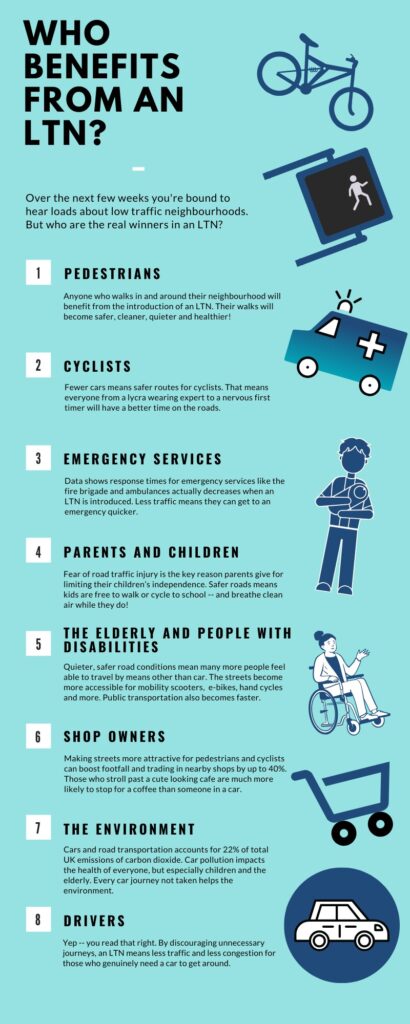What is a Low Traffic Neighbourhood?
Many people who live in residential streets in modern cities are fed up with levels of motor traffic that is too fast, too noisy, too polluting. In some places, most of the traffic is not from residents driving to and from their homes, but short-cutting through from other areas.
A low-traffic neighbourhood (LTN) – also known as a liveable neighbourhood – is a local area where people are better able to walk, cycle, scoot, wheelchair, and enjoy their street and public realm due to a lower level of through traffic.
Shortcutting traffic is prevented through the use of modal filters and bus gates, which means that motor traffic is restricted to access – to households, businesses and services (including emergency services) – and the streets are designed for people rather than motor vehicles.
A modal filter is a physical barrier to motorised traffic, but with gaps that allow people cycling walking or in wheelchairs, buggies etc through. These barriers are usually planters or bollards placed on the road at carefully considered points.
Bus gates similarly allow only buses and taxis, cyclists etc to pass along a road whilst other general traffic is restricted. Both types of restriction can be enforced by police and are backed up by legal orders.
Although these are the most important traffic-reducing measures, further changes to re-design the neighbourhood to put the needs of people above cars might include pocket parks, on-street secure cycle parking hangars, and other measures to help people enjoy the public space around them.
With much lower traffic volumes children can play outside, neighbours can catch up, air pollution is lower, and walking and cycling are the natural choice for everyday journeys for those who are able to.

Although LTNs have featured in the press a lot over recent months (both in Oxford and other UK cities where they are planned or have already been introduced), this is not a new idea. LTNs have been built into planning in European cities for decades. More recently, LTNs have been retrofitted into an entire urban centre in the city of Ghent, leading to a 16% reduction in the proportion of journeys made by car.
Closer to home, it has become standard practice to create cul-de-sacs in new UK developments, in order to make the streets more pleasant, safer and to reduce car dominance. Examples of LTN concepts can be found in our own corner of Oxford (think about filters on Milton Road, Phipps Road, and just two entry/exit points for motor traffic for the whole of Rose Hill). Unfortunately these measures in isolation are not enough to prevent through-cutting or to encourage people to leave the cars behind for short journeys.
The best UK examples of LTNs are in the outer-London borough of Waltham Forest, where the ‘Mini Holland’ scheme was introduced in 2014. Click here to find out more about it and the benefits it has brought to the area.
For more information about LTNs, check out Living Streets introductory guide.